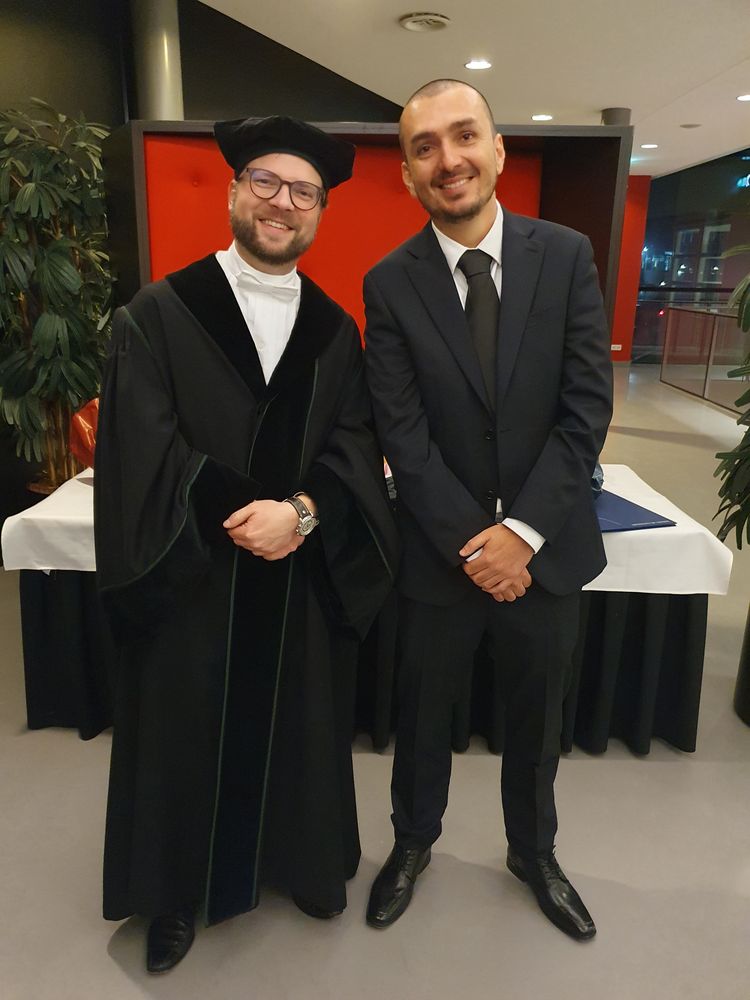On 25 November 2022, Herson Esquivel Vargas successfully defended his PhD thesis with the title „Towards Automated Identification and Assessment of Security Weaknesses in Smart Buildings”.
First supervisor of the thesis was Prof. Dr. Andreas Peter (University of Oldenburg) and second supervisor was Prof. Dr. Pieter Hartel (University of Twente, The Netherlands). Dr. Marco Caselli (Siemens AG) supported the work as external co-supervisor.
Moreover, the following committee members were involved in the assessment of the thesis:
- Prof. Dr. Joost Kok, University of Twente, The Netherlands (chair of committee)
- Prof. Dr. Aiko Pras, University of Twente, The Netherlands
- Prof. Dr. Maarten van Steen, University of Twente, The Netherlands
- Dr. Cristina Alcaraz, University of Malaga, Spain
- Dr. Nile Ole Tippenhauer, CISPA, Germany
- Prof. Dr. Sandro Etalle, Technical University of Eindhoven, The Netherlands
Here’s a short summary of the PhD thesis:
Smart buildings are equipped with computer systems that monitor and control diverse services such as air conditioning, indoor transportation, physical access control, and many others. Critical infrastructures like hospitals, airports, and data centers, leverage on such services to support their daily operations. However, the current popularity of smart buildings is founded on a decades-long history. Smart building systems have evolved from isolated networks using proprietary protocols to IT-integrated systems that use standardized communication protocols. They might even be connected to the Internet to allow remote building management. This transition has exposed smart buildings to a whole new set of security threats. For instance, there have been documented cases where attackers have managed to remotely disrupt the environmental conditions and physical access control of smart buildings. Due to the crucial role that smart buildings play in supporting organizations and the serious threat of cyber attacks against them, there is a pressing need to investigate how to improve their current security posture.
The transfer of mature IT security solutions to smart building systems seems a natural approach to enhance their security, however, the fundamental differences between both domains often require significant adaptation effort or to develop completely new solutions. For this reason, in recent years, a growing body knowledge about smart buildings security has been developed. However, most of these solutions have focused on intrusion detection and little efforts have been made to prevent cyber attacks. An effective way to prevent cyber attacks against smart buildings is by preemptively handling security weaknesses in customized applications and configurations that run the system. Unfortunately, this is often overlooked by smart building administrators due to, e.g., lack of specialized tools, staff, and training. We identify not only a research gap regarding this important task, but also an urgent need to provide (semi-) automated tools that help overcome the limitations faced by smart building administrators. The implementation of these tools requires sophisticated methods that incorporate technical and business-related insights to handle weaknesses according to the organization’s best interest.
In this thesis, we investigate how to implement the first stages of a vulnerability management process for smart building applications and configurations. Beyond just vulnerabilities, we consider the weaknesses that give rise to vulnerabilities. In particular, our contributions address the identification and assessment of security weaknesses for later remediation. These are two key activities to preemptively strengthen the security of smart buildings. The identification of weaknesses is the basis of any vulnerability management process as it provides the first insights about the current security state of a system. This is a challenging task because a deep understanding of the system’s inner workings is often needed to obtain meaningful findings. We propose two approaches to identify security weaknesses; one focused on smart building applications and another on smart building configurations. In the first case, we model the application as a graph data structure comprised of sensors, setpoints, actuators, and control function nodes. The relationships among these components reveal the architecture of the system, which can then be analyzed in the search for security weaknesses. In the second case, we look for component misconfigurations that can be observed in their behavior, i.e., the way they interact with other components in the system. Leveraging official documentation from the components’ manufacturers, we create a model of valid behavior for each of them, which is then compared with their actual behavior as observed in the network traffic. After identifying security weaknesses, we assess the sensitivity of the affected components, which is an important factor to prioritize weaknesses for later remediation. We propose a comprehensive approach to assess the sensitivity of smart building components based on technical and business-related features. The proposed methods are evaluated in real smart buildings and additional experiments are performed in testbeds and comparable simulated environments. These evaluations confirm the feasibility and effectivity of our (semi-) automated weakness identification and assessment approaches.
Link to PhD thesis:



